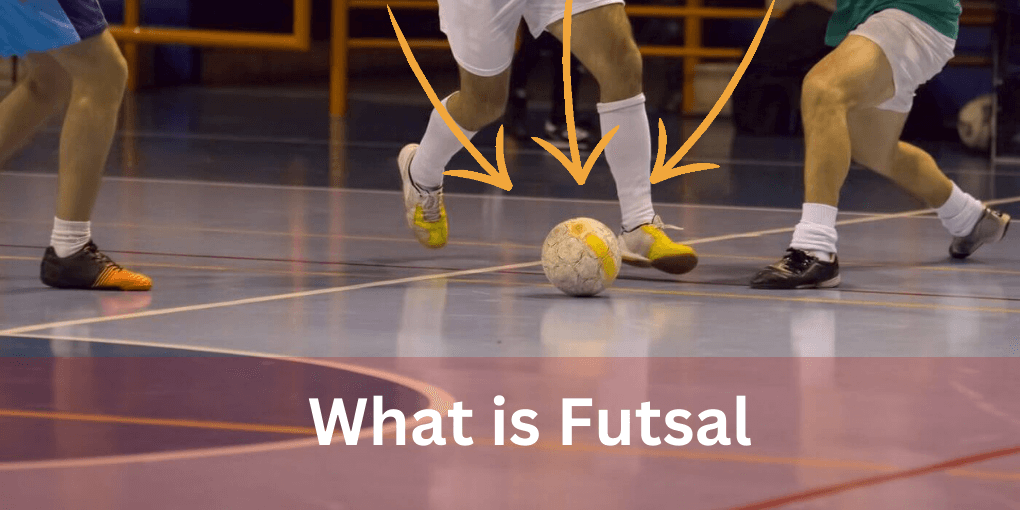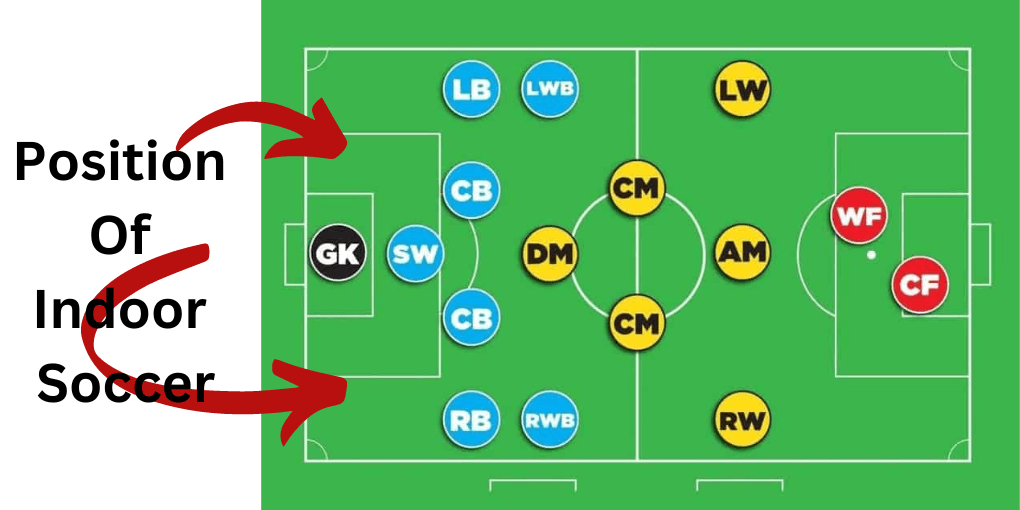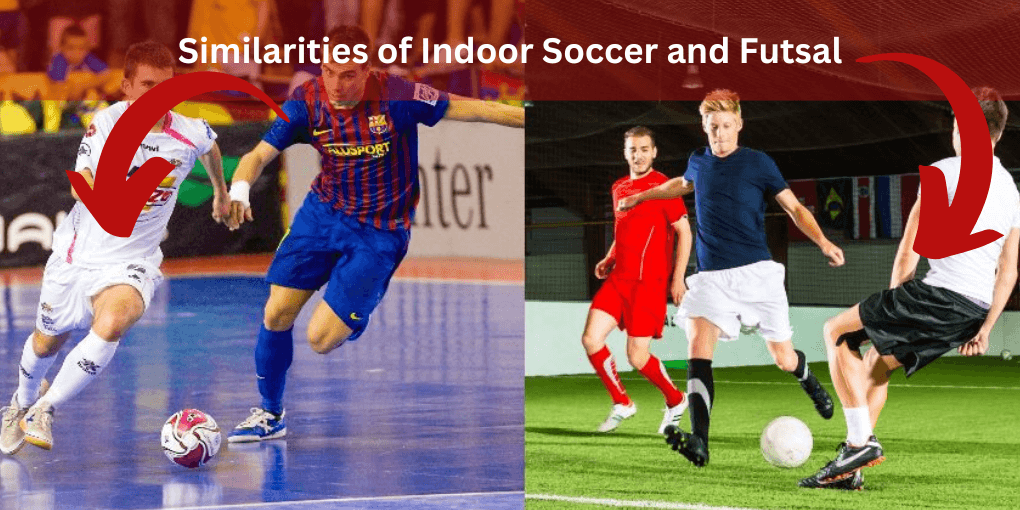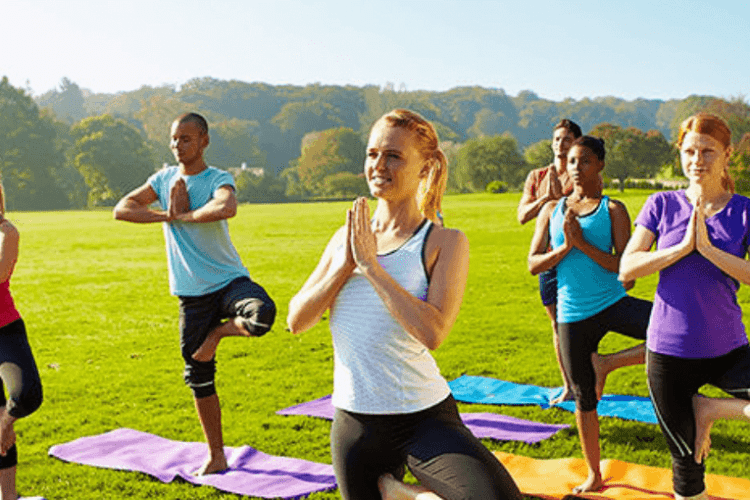Difference Between Futsal vs Indoor Soccer
In the world of sports, there are many interesting ball games, but soccer and futsal are two of them. People used to think that futsal vs indoor soccer were the same. But they are not!

Even though futsal was based in some ways on indoor soccer, there are still some differences between the two games. One of them is the gear used during the game, specifically the shoes.
I am (Im Reko) a game teacher, have been working for many years to teach the players. In this article, I’ll concentrate on the difference between indoor soccer shoes and futsal.
What is Soccer or Indoor Soccer?
Soccer is a team sport played by two 11-player teams on a standardized field with two ‘D zones’ and four goalposts (2 posts make one goal).
The team needs to be evenly distributed across the midfield, defense, attack, flank, and goalkeeper positions.
FIFA and UEFA oversee the regulation of this sport, which is played all over the world.
Soccer matches are either played worldwide or nationally among several clubs, depending on participation.
More than 250 million people participate in soccer in more than 200 countries, making it the most competitive league on earth.
The most popular regions for it include Europe, North and South America, as well as a sizable portion of Asia.
What is Futsal?
Futsal was invented in Uruguay in the 1930s by a teacher named Juan Carlos Ceriani, and it was first meant to be played on a basketball court.

The rules for handball’s pitch field were based on the five-a-side basketball team sizes and 40-minute competition periods.
Then it gained popularity under the shortened name of futsal. It can be challenging to comprehend how futsal teams are set up and configured.
Futsal is an ephemeral sport; therefore, players frequently cover the entire field while still having main roles.
Comparison Table Between Futsal vs Indoor Soccer
| Parameters of Comparison | Indoor Soccer | Futsal |
| Location | Indoor soccer is played indoors on a field or stadium with a roof, as the name would imply. | Contrarily, futsal can be played both inside and outside and is typically played on a smaller field, such as a basketball court, badminton court, or gym. |
| Game Duration | Indoor soccer, like outside soccer, is divided into two halves/periods of 45 minutes each. The game normally lasts 90 minutes. | In futsal, the entire game lasts 40 minutes, with each half lasting 20 minutes. |
| Boundaries | Wales and headboards will be placed along the sidelines of indoor soccer. | Where futsal is played on an indoor court with line markings and a net to define the bounds |
| Playing Surface | Indoor soccer is played on a turf or grass field, with players wearing cleats or soccer shoes. The studs provide superior support and a greater grip when worn. | Futsal is played on a hard court that has a highly rigid feel to it. For optimum traction and confirmation, the player uses shoes with softer soles. |
| Ball Controlling | The turf in indoor soccer reduces the ball’s bounce significantly. | Futsal balls are smaller than those used in indoor soccer. This prevents it from jumping too high and becoming uncontrollable on the hard surface. |
| Substitutes Of Players | 3 Substitutes Allows | Unlimited Substitutions |
| Time Duration | In soccer, there are two 45-minute halves. | Whereas futsal features a 20-minute game with two halves. |
| Ball Dimensions | To be legal, a soccer ball must be 410–450 g in weight and 68–70 cm (27–28 in) in circumference. | A futsal ball has a diameter between 24.61′′ to 25.0′′, which is smaller than a size 4 ball but larger than a size 3 ball. |
Defined Futsal Positions
Futsal requires five on-field players per team: one goalkeeper and four outfield players.

Substitutes can enter the game at any time. Due to the limited court size, all players must contribute to both offensive and defensive play.
When it comes to player positions and roles, though, there is a general rule of thumb. How does your team fare in comparison to the following theory?
Goalkeeper
A crucial position, the goalkeeper is crucial in determining the final score.
This is frequently the friend who is unable to run or is injured but may still contribute to the squad.
Nearly ensuring success at the conclusion of the season and in the finals is having a gun in goals.
Fixo(Fixed Defender)
Typically, the captain and/or team manager of the side. The player that works the hardest both on and off the court.
The person who makes the most effort to assist the goalie from behind in order to prevent the opposition from scoring.
Ala(Left & Right Winger)
On the left and right wings, respectively. The team’s two workhorses are these two players.
The winger position is typically assigned to the two fittest players with the goal of aiding in both offense and defense.
PIVOT (TARGET)
Someone who scores goals, keeps the game moving, or is the pal with the best shot!
The player who prefers to attack rather than defend.
The teammate who is called up every week and who everyone looks to for goals.
Defined Indoor Soccer Positions
Defense and offense are roughly split between each soccer club.

Different players have different goals, including defending or shooting the ball.
In indoor soccer, there is less distinction between the players. Nevertheless, they are given the following roles.
Compared to outdoor soccer, they are more agile and can roam about the pitch with greater freedom.
Goalkeeper
The same regulations apply to all players regardless of position, with the exception of the goalkeeper.
The goalie is the opposition team’s last line of defense.
They were permitted to use their hands to catch or block the ball from entering the goal box.
Defense
The defense is covered by two players, who work with the goalie to keep the other team from scoring.
Midfielder
Midfielders are a three or four-person position that starts in the very front and center of their team’s side of the field.
When necessary, this player can play both forward and defense.
Forward
The forwards are the two or three players who begin the game by positioning themselves in front of the defenders.
They are trying to play the ball into the opposing side of the field to score a goal when they are on offense.
What Is Required For Indoor Soccer Or Futsal?
Futsal
- A goal in futsal. There are two options: an aluminum goal or a movable goal that can be assembled and disassembled as needed. In FIFA-regulated games of American futsal, the former cannot be used unless specific requirements are completed.
- A lighter, smaller ball. Use a Size 4 futsal ball if you are 12 years or older, per US Futsal. Use a Size 3 futsal ball if you’re under 12 years old.
- Players must put on numbered shirts with sleeves, shorts, socks, shin pads, and appropriate footwear when participating in competitive games.
- The goalkeeper must wear the same thing. They should also have a good set of goalkeeping gloves, and they are permitted to wear long pants.
Indoor Soccer
- It is necessary to have an indoor soccer goal that is bigger than a futsal goal but smaller than a conventional goal. There are portable versions available, but rules regarding goal structure and securing must be followed for official games.
- An indoor soccer ball should be a standard size 5 ball for players aged 12 and up and a regular size 4 ball for players younger than 12.
- The same clothing that is worn for futsal must be worn by the players during competitive games.
- When playing indoor football on turf, cleats are necessary. Players frequently wear turf shoes, which are advantageous
Similarities Between Indoor Soccer And Futsal
Technically speaking, indoor soccer and futsal are two different sports.

They both originated in the game of soccer, there are many parallels between the two. The two share the following characteristics.
- Soccer and futsal do not use the offsides rule
- Compared to outdoor soccer, neither sport uses a large field or court
- Both indoor soccer and futsal are frantic and action-packed sports
Advantages and Disadvantages of Futsal and Indoor Soccer
Soccer players and coaches list numerous advantages and disadvantages of futsal.
When compared to indoor soccer, futsal often has the following benefits and drawbacks.
Advantage of Futsal
- Superior ball control is encouraged by the smaller, denser futsal ball.
- According to coaches, this promotes skill development and breaks undesirable habits.
Dis-advantage of Futsal
- The shorter game length in futsal is a key drawback. The amount of time players have to practice and improve might also be reduced if the ball is taken out of play.
- Kicking the ball out of bounds can become a bad habit among players and coaches who want to slow down or stop the game. All players may end up getting less practice time as a result.
Advantages of Indoor Soccer
- Because of the innovative strategies used to utilize the walls, indoor soccer is frequently more entertaining to watch. For passing, dribbling, and scoring, walls are used.
- The soccer ball is the same as that played outside. Additionally, moving from outdoor soccer to indoor soccer is typically simpler than moving from indoor soccer to futsal.
- Indoor soccer matches last longer because of how long the ball is in play against the walls. This translates into greater time for skill improvement.
Dis-advantage of Indoor Soccer
- The use of the barriers by players can become routine, which might encourage sloppy passes and shots. In an outdoor game, it might also lead to poorer accuracy close to the touchline.
- Comparatively more challenging to locate than futsal courts are indoor soccer fields.
Playing Equipment
Hey little athletes, let’s gear up and talk about the cool stuff you need to play indoor soccer and futsal – it’s all about the equipment!
Indoor Soccer Gear
Soccer Shoes: These are like magic shoes for the soccer field! They have special grips for the indoor surface, so you can run super fast and make those awesome moves. Imagine having turbo boosters on your feet!
Shin Guards: Safety first, champs! Shin guards are like superhero armor for your legs. They protect your shins – the front part of your legs – from unexpected kicks and bumps.
Soccer Ball: The most important buddy on the field! The indoor soccer ball is a bit different – it’s like a mini soccer ball. It’s perfect for the smaller space, and you’ll have a blast kicking it around!
Futsal Fun Gear
Futsal Shoes: Time for fancy footwork! Futsal shoes are designed for the special futsal court. They have cool grips to help you dance with the ball and make those slick moves. Imagine having dance shoes for soccer!
Shin Guards: Yep, superheroes wear armor, and so do you! Keep those shins protected with shin guards. You’ll be all set to show off your futsal skills without worrying about bumps.
Futsal Ball: Meet your dance partner! The futsal ball is smaller and bouncier than a regular soccer ball. It loves to groove with your feet on the futsal court, making every game a dance party!
Importance of Skill and Technique in Futsal
Technique refers to the proper way of performing skills. It involves using the right body movements, positioning, and timing to execute skills effectively.
In futsal, having good technique helps players maximize their performance and minimize mistakes.
Efficiency of Movement
With good technique, players can move more efficiently on the futsal court. Proper body positioning and footwork enable them to change direction quickly, accelerate faster, and maintain balance during challenging situations.
Tactical Awareness
Technique helps players to make quick decisions and react swiftly to the changing dynamics of the game.
It allows them to anticipate and adapt to different situations, working in sync with their teammates to outwit the opposing team.
Injury Prevention
By using correct technique, players can reduce the risk of injuries. Proper body mechanics and technique minimize the strain on muscles and joints, ensuring that players stay safe and healthy while playing the game they love.
Benefits and Challenges
Life is full of ups and downs, like a coaster ride. In this article, we’ll discover the benefits and challenges that we may encounter along our.
From the exciting advantages that make us happy to the tricky hurdles that teach us important lessons, let’s dive right in!
Benefits
Learning and Growth: Facing challenges helps us learn and grow. When we overcome obstacles, we become stronger, smarter, and more capable. Challenges push us to think creatively, find solutions, and develop new skills that will be useful throughout our lives.
Building Resilience: Dealing with challenges builds resilience, which is like having a superpower! Resilience helps us bounce back from difficult situations, stay positive, and keep trying even when things get tough. With resilience, we can face any challenge with confidence and determination.
Discovering Strengths: Challenges often reveal hidden strengths within us. When we face tough situations, we discover talents, abilities, and inner resources that we didn’t know we had. These strengths can become our superpowers and help us tackle future challenges.
Challenges
Fear and Uncertainty: Facing challenges can sometimes make us feel scared or unsure. It’s normal to have these feelings, but remember that fear can be overcome. Take a deep breath, believe in yourself, and take small steps forward. You’ll be amazed at what you can achieve!
Persistence and Patience: Challenges often require persistence and patience. Sometimes, things won’t work out right away, and that’s okay. Keep trying, adjust your approach if needed, and never give up. Remember, even the greatest inventors and explorers faced failures before they succeeded.
Asking for Help: It’s not always easy to ask for help when facing challenges. However, asking for support is a courageous thing to do. Reach out to trusted friends, family members, or teachers. They can offer guidance, advice, and encouragement to help you overcome challenges.
Physical Demands of Both Sports
Let’s talk about the physical demands of two: soccer and basketball Both of these sports require different skills and abilities, and here’s a simple explanation of what they involve:
Soccer
Soccer is a game that is played using mainly your feet. It requires running, jumping, and kicking the ball.
Running is a big part of soccer, so players need to have good endurance and be able to run for a long time without getting tired.
They also need to be quick and agile so that they can change direction quickly and avoid opponents. Kicking the ball requires using your leg muscles, so players need to have strong legs.
Soccer players also need to be good at balancing and have good coordination to control the ball while running.
Basketball
Basketball is a game played with a ball and a hoop. It involves running, jumping, dribbling, and shooting.
Like soccer, basketball players need to have good endurance because the game is fast-paced and involves a lot of running up and down the court.
They also need to be quick and agile move around their opponents and find an open space.
Jumping is very important in basketball because players need to be able to shoot the ball into the hoop.
So, basketball players need strong leg muscles to jump high and have good coordination to shoot accurately.
Dribbling is another important skill in basketball where players bounce the ball with their hand while running, so players need good hand-eye coordination.
Skill development in futsal vs. indoor soccer
Are a soccer enthusiast but not sure about the differences between futsal and indoor soccer?
Don’t worry! In this article, we’ll explore how skill development differs in futsal and indoor soccer. Get ready to dive into the exciting world of futsal and indoor soccer!
Futsal Skills
Futsal is a fast-paced indoor game played with a smaller, heavier ball on a small court. Here are some key skills you can develop in futsal:
Ball Control: Futsal emphasizes excellent ball control. Since the ball is smaller and heavier, you’ll need to practice keeping it close to your feet. Try dribbling around cones or using both feet to improve your ball control skills.
Quick Passing: In futsal, passing the ball quickly is essential to keep the game flowing. Focus on accuracy and quick decision-making when passing to teammates. Practice passing drills with a partner or against walls to enhance your passing skills.
Agility and Footwork: Futsal requires quick movements and fancy footwork. Work on your agility by practicing quick turns, pivots, and quick changes of direction. Improving your footwork will make it easier to evade opponents and create scoring opportunities.
Indoor Soccer Skills
Indoor soccer is played with a larger, lighter ball on a bigger field. Let’s discover some key skills for indoor soccer:
Speed and Endurance: Indoor soccer demands bursts of speed and stamina due to the larger playing area. To improve speed, try sprint exercises or agility drills. Building endurance through regular exercises and practice games will support you during longer matches.
Shooting Accuracy: In indoor soccer, aim for accurate shots due to the larger goal size. Practice shooting from different angles and distances to improve your accuracy. Developing a strong and precise shot will increase your chances of scoring goals.
Teamwork and Positioning: Indoor soccer involves more players, so teamwork and positioning are important. Understand your role in the team, communicate with your teammates, and find good passing opportunities. Mastering positioning will help create scoring chances and defend effectively.
Choosing Between Futsal vs Indoor Soccer
Are you ready to play an indoor soccer game but can’t decide between futsal vs indoor soccer?

Don’t worry, we’re here to help! In this article, we’ll explore the differences between futsal vs indoor soccer to help you make the best choice for your playing style and preferences. Let’s kick off the decision-making process!
Indoor Soccer
Indoor is played on a larger field with a lighter ball. Here are some things to consider about indoor soccer:
Space and Speed: Indoor soccer gives you more space to run and move around. The larger field allows for longer runs and faster gameplay. If you love speed and using your endurance, indoor soccer might be the right choice for you.
Teamwork and Positioning: Since indoor soccer involves more players on the field, teamwork and positioning are crucial. You’ll have more opportunities to work as a team, coordinate passes, and score goals together. If you enjoy playing with lots of teammates and strategizing, indoor soccer could be your game.
Shooting Opportunities: In indoor soccer, you’ll have more chances for long-distance shots due to the larger goal size. If you love taking powerful shots and scoring goals from different angles, indoor soccer might be the game for you.
Futsal
Futsal is played on a smaller court with a smaller, heavier ball. Here’s what you should know about futsal:
Skill and Technique: Futsal focuses on individual skill and technique. The smaller playing area and ball require excellent ball control, quick passes, and fancy footwork. If you enjoy showing off your dribbling skills and creative moves, futsal might be your game.
Quick Decision-Making: Futsal demands quick decision-making due to the fast and dynamic nature of the game. With less space, you’ll need to think fast and adapt to changing situations. If you like making split-second decisions and playing a fast-paced game, futsal could be the right choice for you.
Close Ball Control: Since the futsal ball is smaller and heavier, you’ll need to keep it close to your feet and maneuver around opponents. If you enjoy close control and dribbling the ball with finesse, futsal might be the perfect fit for you.
Choosing between futsal vs indoor soccer depends on your preferences and playing style.
If you enjoy speed, teamwork, and shooting opportunities, indoor soccer is a great choice.
On the flip side, if you love individual skill development, quick decision-making, and close ball control, futsal might be the game for you.
Remember, both games offer exciting challenges and opportunities to have a blast on the indoor field.
So, try them both if you can and see which one brings you the most joy and satisfaction. Have fun and keep playing your favorite indoor game!
Future Trends and Innovations
world is constantly changing, and new ideas and inventions are shaping the future.
In this article, we’ll explore some exciting future trends and innovations that might revolutionize the way we live, play, and learn. Get ready to embark on a journey of imagination and discovery!
Technology Enhancements
Technology is advancing at an incredible pace, and it will continue to impact our lives in amazing ways. Here are a few examples:
Smart Homes: Imagine living in a home where everything is automated – lights, temperature, and even your appliances. Smart homes will make our lives easier and more convenient.
Virtual Reality: Virtual reality technology will transport us to different places and let us experience things in a whole new way. We could visit historical sites, explore the depths of the ocean, or even travel to outer space without leaving our homes.
Renewable Energy
Protecting our planet is crucial, and renewable energy will play a significant role in our future. Here are some innovations in renewable energy:
Solar Power: Solar energy harnesses the power of the sun to generate electricity. With advancements in solar panel technology, solar power will become more accessible and widely used.
Wind Power: Wind turbines convert wind energy into electricity. These turbines are becoming more efficient and can be used on a small or large scale to generate clean energy.
Transportation Innovations
The way we travel is also evolving. Here are a couple of transportation trends that could shape the future:
Electric Vehicles: Electric cars are becoming more popular as they are environmentally friendly and reduce our reliance on fossil fuels. In the future, more electric vehicles will be on the roads, making our air cleaner.
Hyperloop: Imagine traveling at incredible speeds in a pod inside a vacuum tube. The Hyperloop concept aims to make this possible, revolutionizing long-distance travel and reducing travel times significantly.
Conclusion
Some of the most popular sports practiced worldwide include soccer and futsal, both of which demand a high level of talent to succeed.
Both soccer and futsal share the goal of scoring “goals,” and both sports are regarded as strategic and tactical games that demand pure collaboration.
I’m attempting to cover all of the important aspects of futsal vs indoor soccer. Hopefully, you find this guide to be enjoyable and educational.
FAQs
Futsal is played 5V5, which means that five players from each team may participate at once. There are therefore five positions on the pitch that can be filled.
The majority of positions do not have defined rules. Regardless of position, a player's freedom of movement on the field is important. But the goalkeeper is unable to move up the field and must remain in place the entire time.
To play each position is challenging in a different way. The hardest position is that of the goalkeeper since he must safeguard the pivot to preserve the goal.
Rather than using a smaller, heavier ball, this is 6v6 indoor soccer on turf with boards and plexiglass.
Tennis shoes or flat indoor soccer shoes will work just fine


